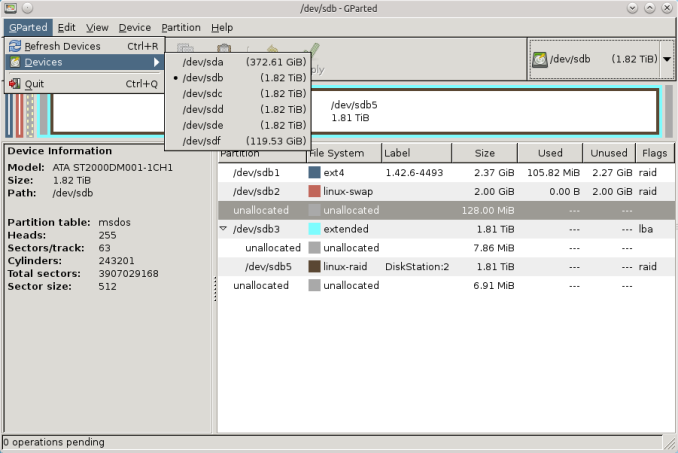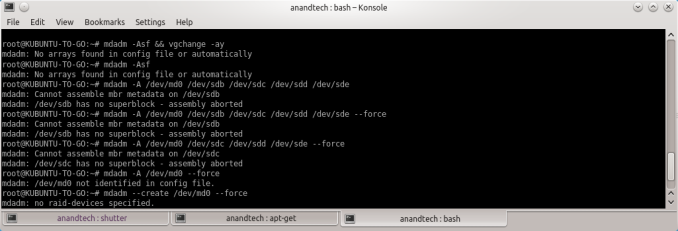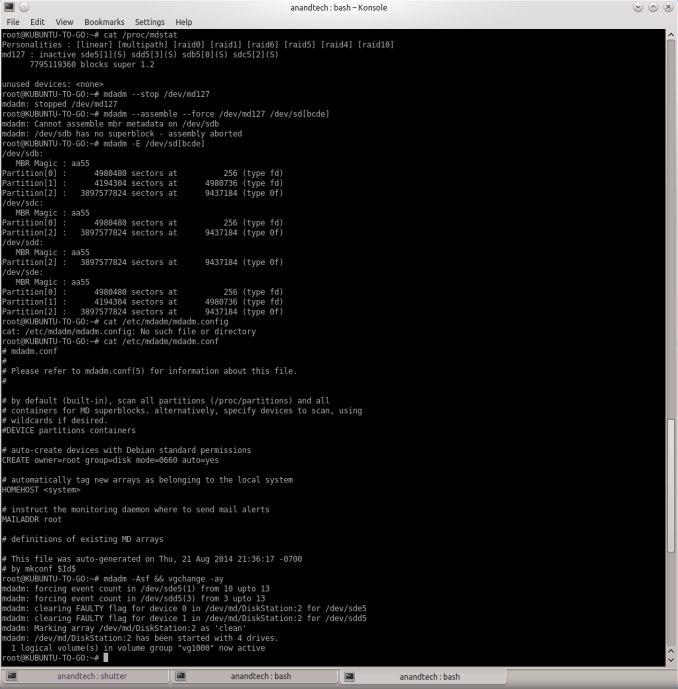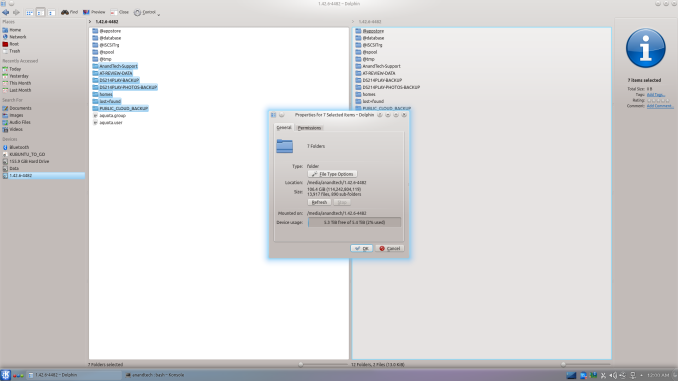Recovering Data from a Failed Synology NAS
by Ganesh T S on August 22, 2014 6:00 AM ESTRecovering the Data
Ubuntu + mdadm
After booting Ubuntu with all the four drives connected, I first used GParted to ensure that all the disks and partitions were being correctly recognized by the OS.
Synology's FAQ presents the ideal scenario where the listed commands work magically to provide the expected results. But, no two cases are really the same. When I tried to follow the FAQ directions, I ended up with a 'No arrays found in config file or automatically' message. No amount of forcing the array assembly helped.
After a bit of reading up the man pages, I decided to look up mdstat and found that a md127 was actually being recognized from the Synology RAID operations. Unfortunately, all the drives had come up with a (S) spare tag. I experimented with some more commands after going through some Ubuntu forum threads.
The trick (in my case) seemed to lie in actually stopping the RAID device with '--stop' prior to executing the forced scan and assemble command suggested by Synology. Once this was done, the RAID volume automatically appeared as a Device in Dolphin (a file explorer program in Ubuntu).
The files could then be viewed and copied over from the volume to another location. As shown above, the ~100 GB of data was safe and sound on the disks. Given the amount of time I had to spend searching online about mdadm, and the difficulties I encountered, I wouldn't be surprised if users short on time / little knowledge of Linux decide to go with a Windows-based solution even if it costs money.
Windows + UFS Explorer
Prior to booting into Windows, I had all the four drives and the LaCie DAS connected to our DAS testbed. The four drives were recognized as having unknown partitions (thanks to most of them being in EXT4 format). However, that was not a problem for UFS Explorer. All the partitions in all the connected drives were recognized correctly and the program even presented the reassembled RAID-5 volume at the very end.
After this, it was a simple process of highlighting the appropriate folders in the right pane and saving it to one of the disks in the DAS.
Fortunately, I had only around 100 GB of data in the DS414j at the time of failure, and I got done with the recovery process less than 10 hours after waking up to the issue.





















55 Comments
View All Comments
Impulses - Friday, August 22, 2014 - link
While I generally agree with your logic (having never given my desktop up as my primary system, and being single), saying "just plug the laptop in via TB" or whatever isn't exactly a viable alternative for many users.I don't own a NAS, but it seems to me the biggest market for units are laptop dependant and/or multi-user households... When you have a couple and possibly kids each with their own laptop it's much easier to have a centralized media store in a NAS than anything directly attached.
Gigaplex - Saturday, August 23, 2014 - link
"A consumer can just buy high availability as a service (such as from Amazon services)"Not on ADSL2+ when dealing with multiple TBs of data I can't.
wintermute000 - Saturday, August 23, 2014 - link
QFTWHangFire - Friday, August 22, 2014 - link
Losing a day's work is considered acceptable in most environments. In theory yesterday (or last Friday) is fresh in everyone's mind, and the raw source material (emails, experimental data, FAXes, etc.) are still available in their original form to redo any data entry.What is interesting about the QSync situation is the cascading affect of failures. If caught early, through log examination, dashboards, whatever, true disaster can be averted. If minor issues like sync fails are allowed to continue, and RAID failure follows, say, a month later, then a month's worth of work can be lost. That is not acceptable in any environment.
Kougar - Friday, August 22, 2014 - link
Thanks for the article! I have a ~6 year old TS-409 Pro that is still running great, but internal component failure has been on my mind for awhile now. I'll be bookmarking this in case I ever need to use recovery options on it as I wasn't aware of either of these tools!kmmatney - Friday, August 22, 2014 - link
Nice article! I use a WHS 2011 server, with Stablebit DrivePool for redundancy. The nice thing about Drivepool is that the drives are kept in standard NTFS format. You can just take the drive out, and plug it into any computer to retrieve files, so data recovery is a piece of cake.Impulses - Friday, August 22, 2014 - link
Shame WHS is now RIPDanNeely - Friday, August 22, 2014 - link
Yeah. I'm really hoping ZFS or Btrfs NASes (without huge price premiums) will be available in the next year and a half as reasonable replacements for my current WHS 2011 box.Impulses - Friday, August 22, 2014 - link
That'd be nice, I never bought my own but I recommended and set up several for various clients & family members with small businesses...No clue what I'd tell them to migrate to right now if one were to break down, the ease of recovery and expansion was one of the biggest draws to WHS and in fact the reason many picked it over cheaper NAS boxes.
Gigaplex - Saturday, August 23, 2014 - link
There's a reason it was killed off. It has some serious design flaws that trigger data corruption, and Microsoft couldn't figure out how to resolve them. It has great flexibility but I wouldn't trust it with my data.